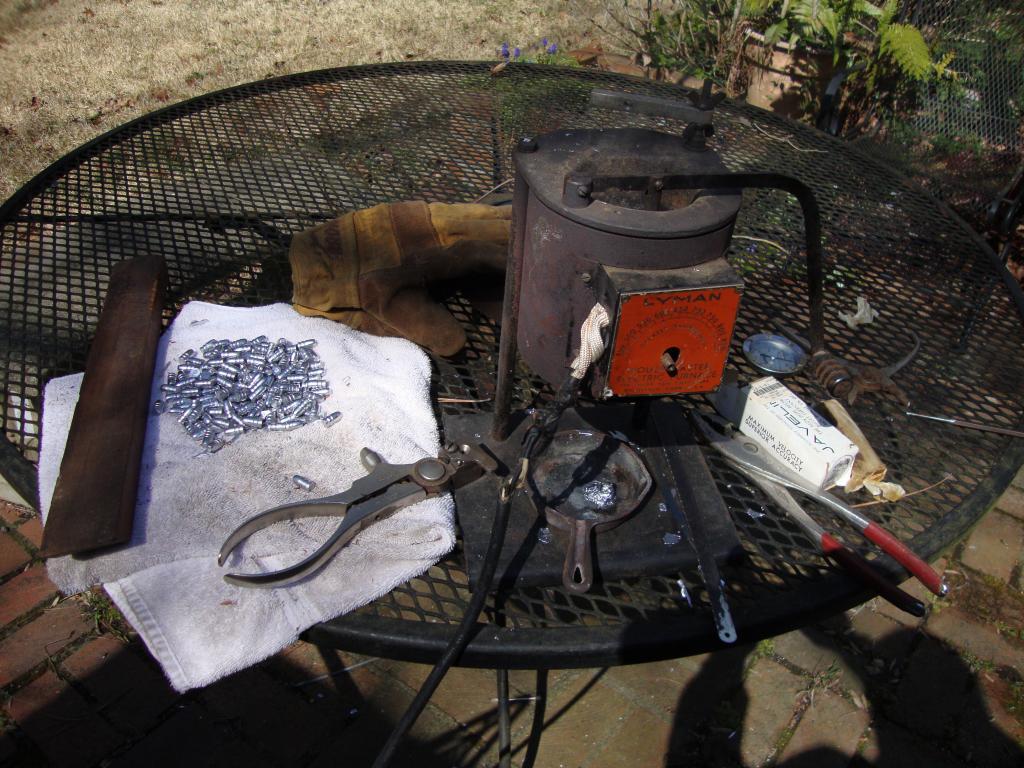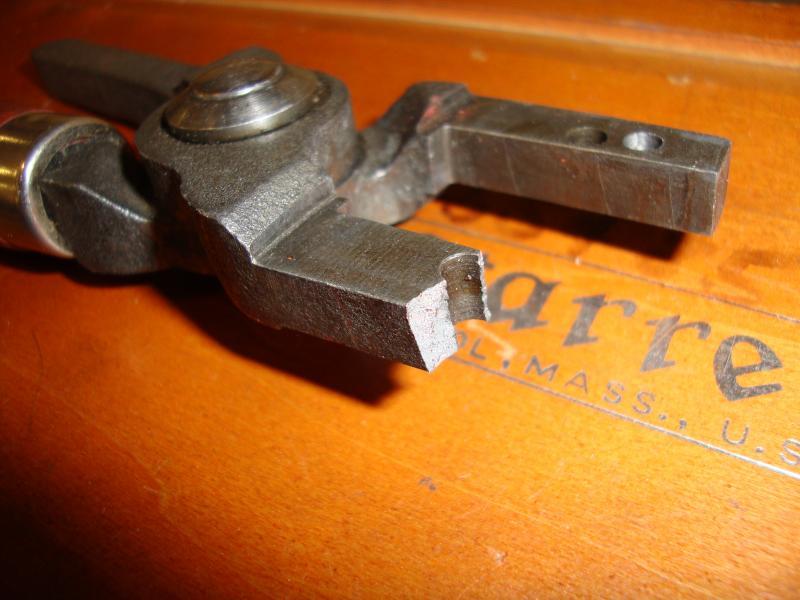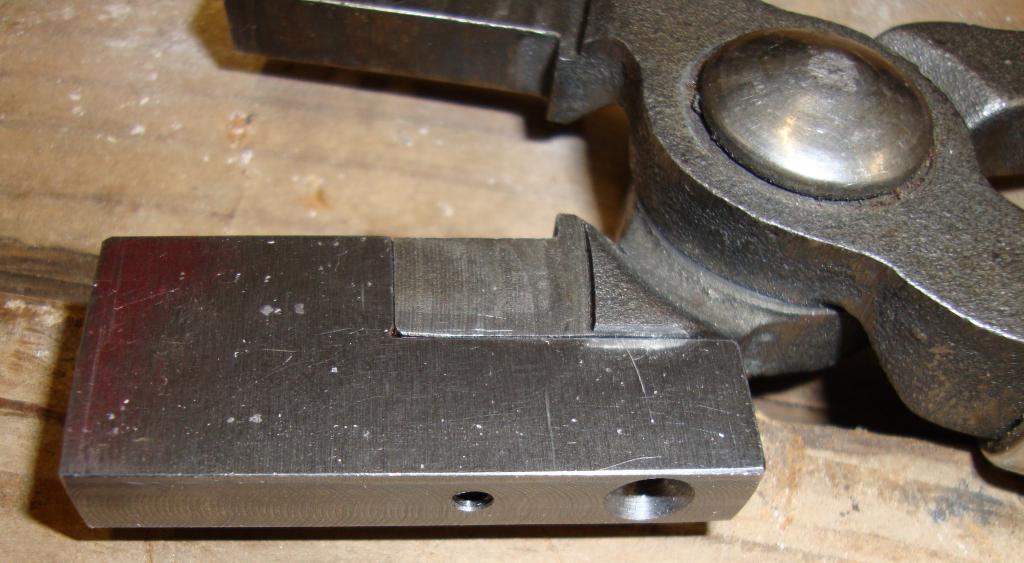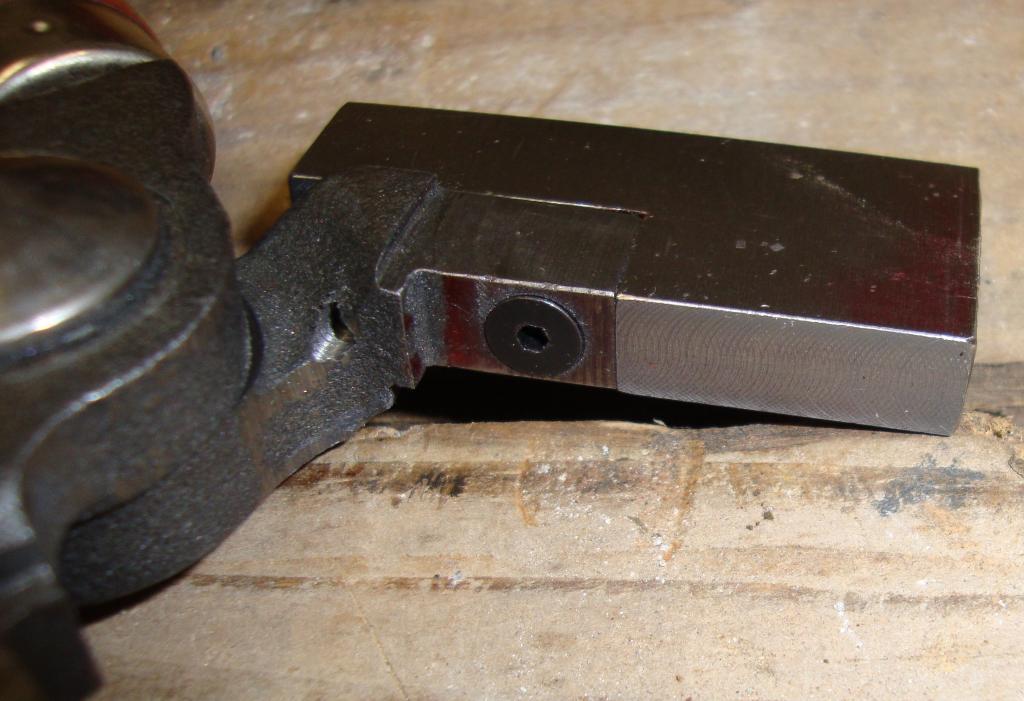-
Bullet Casting Woes
After a very productive weekend session casting bullets for the 32-20s, yesterday's attempt was quite the opposite! Spent two + hours and only produced five marginally good 454429 bullets. Apparently the ingots used to replenish the pot were contaminated as the surface tension went sky high. Couldn't get a good fill with any of the three moulds tried. Fluxed the pot multiple times, ran the heat up well past the usual, made sure the moulds were heated well and degreased, all to no avail. Even added some known good linotype which seems to be a waste at this point.
But the worst part was after accidentally dumping the new .43 Spanish mould assembly into the melt. First time for that! More or less encased the mould and the outer portion of the handles in lead. Bother! Finally pried the mess off, only to discover that the lead had grabbed the tip of the handle well enough to break the cast iron off at the screw hole.
And it's the only large set of Lyman handles I own for some odd reason! (Three small handle sets about, which don't seem very feasible to convert, so no help there.) And none in stock for any of the usual suppliers.
Anybody ever attempt repair on a set of Lyman handles before?
All of this recent bullet casting activity has actually been due to the anticipation of getting the .43 Spanish caliber rifles up and running, but it's been one delay after another...
Now to purge the pot and hunt up a more reliable source of lead...Never have considered paying other than scrap prices, if anything, for the stuff, but it's another commodity in short supply it seems due to the ongoing feeding frenzy in the US.
Gratutitous photo from an earlier, happier session:

Information
 |
Warning: This is a relatively older thread
This discussion is older than 360 days. Some information contained in it may no longer be current. |
|
-
-
04-23-2013 05:17 AM
# ADS
Friends and Sponsors

-
Advisory Panel


Broke one - and repaired it
Based on my own experience:
1) The best source of pure-enough lead is lead flashing as used by roofers. It has to be pretty pure to be sufficiently malleable.
2) You do not need 99.99% chemically pure lead, that is just wasting money.
3) But you should avoid wheel weights and any other supposedly favourable source of scrap recommended by someone at the bar who knows about as much about metallurgy as I do about Sanskrit. As you have found out, the hard way, it only takes tiny amounts of some impurities to ruin the alloy.
4) Repeat: stick to lead flashing.
5) So-called "fluxing" can only have an effect (if any) on the top of the melt, where it may indeed reduce oxidation. But anyone who thinks that all the various snake-oils that are proposed as flux actually penetrate into the melt and mix with the alloy should think again. If a steel mould floats on molten lead, be sure that beeswax, earwax, whatever... cannot do anything else but also float on top.
6) For BP applications, hardening with tin is all you need. And the simplest way of acquiring tin is in the form of good-old eutectic solder as used for electronics work. 5% tin provides a BH of about 10. It's not critical, so I avoid brain strain and add 8% solder by weight (which I can calculate in my head) to the lead, for BPCRs, or 5% solder (approx. 3% tin, or BH 8) for percussion rifles, such as the Gibbs. Pure lead is, by definition, BH 5.
And finally, from the "been there, done that" department:
I, too, have managed to break a (Lyman?) mould handle, about a year ago. And under sheer desperate time pressure, silver-soldered the pieces together.
The material seems to be a kind of brittle steel, but not pure cast iron (thank heavens).
Attachment 42444
Not pretty, but it is still working after a year. Try it - you have nothing to lose!
Last edited by Patrick Chadwick; 04-23-2013 at 01:22 PM.
-
Thank You to Patrick Chadwick For This Useful Post:
-
-
Legacy Member

I use wheel weights all the time. Having said that I also have a way to avoid zinc contamination. USE A THERMOMETER! Keep the heat below the temp needed to melt zinc. It will float at the top and you can pick it off easily, Yes, it does slow down the smelting process quite a bit, but it avoids the problem you appear to be having. And no, I do not know any practical method of removing the zinc once it gets into the mix.
When they tell you to behave, they always forget to specify whether to behave well or badly!

-
Thank You to jimb16 For This Useful Post:
-
Fortunately, it doesn't seem to be a zinc problem. The batch was melted again today and was found to solidify at 580°F over a narrow temperature band. Drained a fair amount off, gave it a heavy fluxing with sawdust stirred in well after charring and added a little more linotype to get the "freeze point " down to 550°F. Moulds degreased again for good measure and managed to cast some good 32-20 projectiles, which is the current known "good" baseline. Had to run the pot at about 720°F for good fill, but that's acceptable, if a little warmish.
The mould handle breakage is now the major drama. There's very little "meat" at the screw hole, and the temps will get fairly high, so silver soldering might not do so well. May have to scab on a reinforcing plate on the outboard side of the jaw. Complete jaw replacement would be another possibility, but isn't looking like a wonderful project. Will probably be the weekend before any progress is made.
-
-
Advisory Panel



Originally Posted by
jmoore

There's very little "meat" at the screw hole, and the temps will get fairly high, so silver soldering might not do so well. May have to scab on a reinforcing plate on the outboard side of the jaw.
Do it. The steel is annoyingly brittle, so the silver-soldering will make it less so. In fact, annealing the lot might be a good idea.
-
-
FREE MEMBER
NO Posting or PM's Allowed

My problem is getting each casting to a similar weight. Can hardly hope for precision with quite large differences in bullet weight. I have to reject about 40% of castings just to achieve a limit of about 2 grains variation in weight.
-

Originally Posted by
Patrick Chadwick

Do it. The steel is annoyingly brittle, so the silver-soldering will make it less so
This pair appears to be cast iron. Won't be reattaching the old jaw piece, now: machined the jaw square on the outer face and fractured end during lunch break. Now to round up some 5/6" thick stock. (Not likely here, it's all wierd nickel alloys, titanium, aluminum, etc.) Probably some at home, though.

Originally Posted by
villiers

My problem is getting each casting to a similar weight. Can hardly hope for precision with quite large differences in bullet weight. I have to reject about 40% of castings just to achieve a limit of about 2 grains variation in weight.
I've had very good success up until a couple of days ago keeping weights very uniform. Couldn't tell you why, though! Usually, light bullets mean air pockets inside if the outside look good. Used to reject lots of bullets for that problem as accuracy is terrible when the offbalanced ones sneak by. Have long since started weighing all of them! Store bought bullets for speed. Home brewed for accuracy. ETA: And desparation! Not too many "store bought" bullets out there for Werders.
Last edited by jmoore; 04-24-2013 at 04:50 AM.
-
Thank You to jmoore For This Useful Post:
-
Legacy Member

Casting issues
My best friend is the go to guy for bullet casting issues. That is all he does. He is moderator on the cast boolit (correct spelling for site) forums if you are familiar with that forum site. He can answer and help. His name is Ben Hays. Try him for advice. bena.hays@gmail.com
Jason
-
Thank You to JasonA For This Useful Post:
-

Originally Posted by
JasonA

He is moderator on the cast boolit (correct spelling for site) forums if you are familiar with that forum site.
Have lurked on that site quite a bit lately. Also have been perusing the old Lyman Cast Bullet Handbook and other old books that have served well in the past. Never have really enjoyed casting bullets (or boolits), but sometimes it's proven to be the best solution to getting the most out of a particular firearm.
-
-
-
The Following 2 Members Say Thank You to jmoore For This Useful Post:
 Information
Information


















 PM
PM













